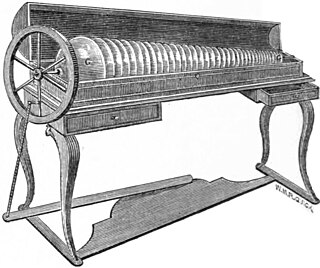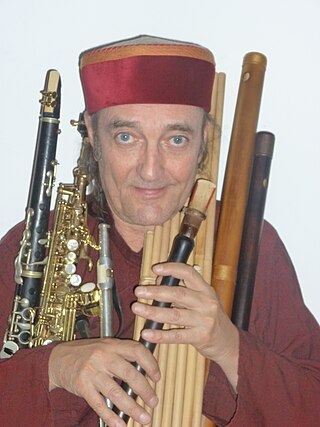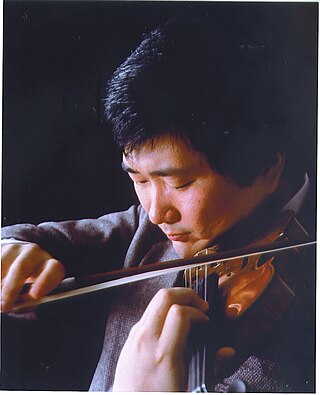The gumbass is a French musical instrument. It is a cross between a guembri and an electric bass. [1]
The gumbass was invented by musician Loy Ehrlich. [2] He plays the instrument in the musical group Hadouk Trio. [3]
- Loy Ehrlich playing the gumbass
The gumbass is a French musical instrument. It is a cross between a guembri and an electric bass. [1]
The gumbass was invented by musician Loy Ehrlich. [2] He plays the instrument in the musical group Hadouk Trio. [3]

The oud is a short-neck lute-type, pear-shaped, fretless stringed instrument, usually with 11 strings grouped in six courses, but some models have five or seven courses, with 10 or 13 strings respectively.

Gamelan is the traditional ensemble music of the Javanese, Sundanese, and Balinese peoples of Indonesia, made up predominantly of percussive instruments. The most common instruments used are metallophones played by mallets and a set of hand-played drums called kendhang/Kendang, which register the beat. The kemanak and gangsa are commonly used gamelan instruments in Bali. Other instruments include xylophones, bamboo flutes, a bowed instrument called a rebab, a zither-like instrument siter and vocalists named sindhen (female) or gerong (male).

Music of Nepal refers to the various musical genres played and listened to in Nepal. With more than fifty ethnic groups in Nepal, the country's music is highly diverse. Genres like Tamang Selo, Chyabrung, Dohori, Adhunik Geet, Bhajan, Filmi music, Ghazal, Classical music, songs and Ratna music are widely played and popular, but many other less common genres are yet to be cataloged. Western musical genres like Rock, Metal, Hip-Hop, Rap, R&B also regularly feature on the Nepalese music charts. Most of the country's musical bands are based in the Kathmandu valley. Musical genres from Tibet and India have greatly influenced Nepalese music.

The glass harmonica, also known as the glass armonica, glass harmonium, bowl organ, hydrocrystalophone, or simply the armonica or harmonica, is a type of musical instrument that uses a series of glass bowls or goblets graduated in size to produce musical tones by means of friction. It was invented in 1761 by Benjamin Franklin.
The music of Saudi Arabia includes both Western and traditional music. The most distinguished musician in recent Saudi history is Tariq Abdulhakeem, who composed hundreds of famous Saudi songs for himself as well as for other singers; Saraj Omar has become a very prominent composer after writing the music for the Saudi national anthem; Mohammed Abdu, the most famous singer in the Arab World; Talal Maddah who died in August 2000 while singing in the summer festival on the stage of Al-Muftaha Theatre in the southern region of Saudi Arabia. The 1st Arab Pioneers Festival, which was held in Cairo under the patronage of the Arab League, honored four of the lead composers in Saudi Arabia: Tariq Abdulhakeem, Ghazi Ali, Mohamed Alsenan, and Mohammed Shafiq. Of the same generation are the oud virtuoso Abadi al Johar, Rabeh Saqer and Abdul-Majeed Abdullah.
The Roland Jupiter-6 (JP-6) is a discontinued synthesizer, manufactured and introduced by the Roland Corporation in January 1983.

The duduk or tsiranapogh, is a double reed woodwind instrument made of apricot wood originating from Armenia. Variations of the Armenian duduk appear throughout the Caucasus and the Middle East, including Azerbaijan, Georgia, Russia, Turkey, and Iran. Duduk, Balaban, and Mey are almost identical, except for historical and geographical differences.

Didier Malherbe, is a French jazz, rock and world music musician, known as a member of the bands Gong and Hadouk, as well as a poet.

The rebab is the name of several related string instruments that independently spread via Islamic trading routes over much of North Africa, Southeast Asia, the Middle East, and parts of Europe. The instrument is typically bowed, but is sometimes plucked. It is one of the earliest known bowed instruments, named no later than the 8th century, and is the parent of many bowed and stringed instruments.

C. Bechstein Pianoforte AG is a German manufacturer of pianos, established in 1853 by Carl Bechstein. Along with Blüthner, Bösendorfer and Steinway & Sons, C. Bechstein is frequently referred to as one of the "Big Four" piano manufacturers.

The fujara is a large wind instrument of the tabor pipe class. It originated in central Slovakia as a sophisticated folk shepherd's overtone fipple flute of unique design in the contrabass range.

Shankar–Ehsaan–Loy is an Indian musical trio consisting of Shankar Mahadevan, Ehsaan Noorani and Loy Mendonsa. They have composed music for over 50 soundtracks across five languages: Hindi, Tamil, Telugu, Marathi and English. Amongst the most critically acclaimed Indian musicians, the trio have won numerous awards, including National Film Award (India), Filmfare Awards, and IIFA Awards. They are often referred to as the "Amar Akbar Anthony" of the Hindi film music industry.
Miguel Angel Varvello is an Argentinian musician who plays and teaches the bandoneon.

Konchem Ishtam Konchem Kashtam is a 2009 Indian Telugu-language romantic comedy film directed by debutant Kishore Kumar Pardasani. The film stars Siddharth, Tamannaah, Prakash Raj, Ramya Krishna, and Nassar while Brahmanandam and Venu Madhav play supporting roles. The film has score composed by Mani Sharma with the soundtrack by trio Shankar–Ehsaan–Loy.

Chin Kim is a Korean-born American classical violinist, largely educated in the United States through the Juilliard School, and the Curtis Institute of Music.
Gareth Loy is an American author, composer, musician and mathematician. Loy is the author of the two volume series on the intersection of music and mathematics titled Musimathics. Loy was an early practitioner of music synthesis at Stanford, and wrote the first software compiler for the Systems Concepts Digital Synthesizer. More recently, Loy has published the freeware music programming language Musimat, designed specifically for subjects covered in Musimathics, available as a free download. Although Musimathics was first published in 2006 and 2007, the series continues to evolve with updates by the author and publishers. The texts are being used in numerous math and music classes at both the graduate and undergraduate level, with more current reviews noting that the originally targeted academic distribution is now reaching a much wider audience. Music synthesis pioneer Max Mathews stated that Loy's books are a "guided tour-de-force of the mathematics of physics and music... Loy has always been a brilliantly clear writer. In Musimathics, he is also an encyclopedic writer. He covers everything needed to understand existing music and musical instruments, or to create new music or new instruments... Loy's book and John R. Pierce's famous The Science of Musical Sound belong on everyone's bookshelf, and the rest of the shelf can be empty." John Chowning states, in regard to Nekyia and the Samson Box, "After completing the software, Loy composed Nekyia, a beautiful and powerful composition in four channels that fully exploited the capabilities of the Samson Box. As an integral part of the community, Loy has paid back many times over all that he learned, by conceiving the (Samson) system with maximal generality such that it could be used for research projects in psychoacoustics as well as for hundreds of compositions by a host of composers having diverse compositional strategies."

Loy Ehrlich is a French musician, composer and producer based in Paris.
Steve Shehan is a French-American percussionist and music composer.